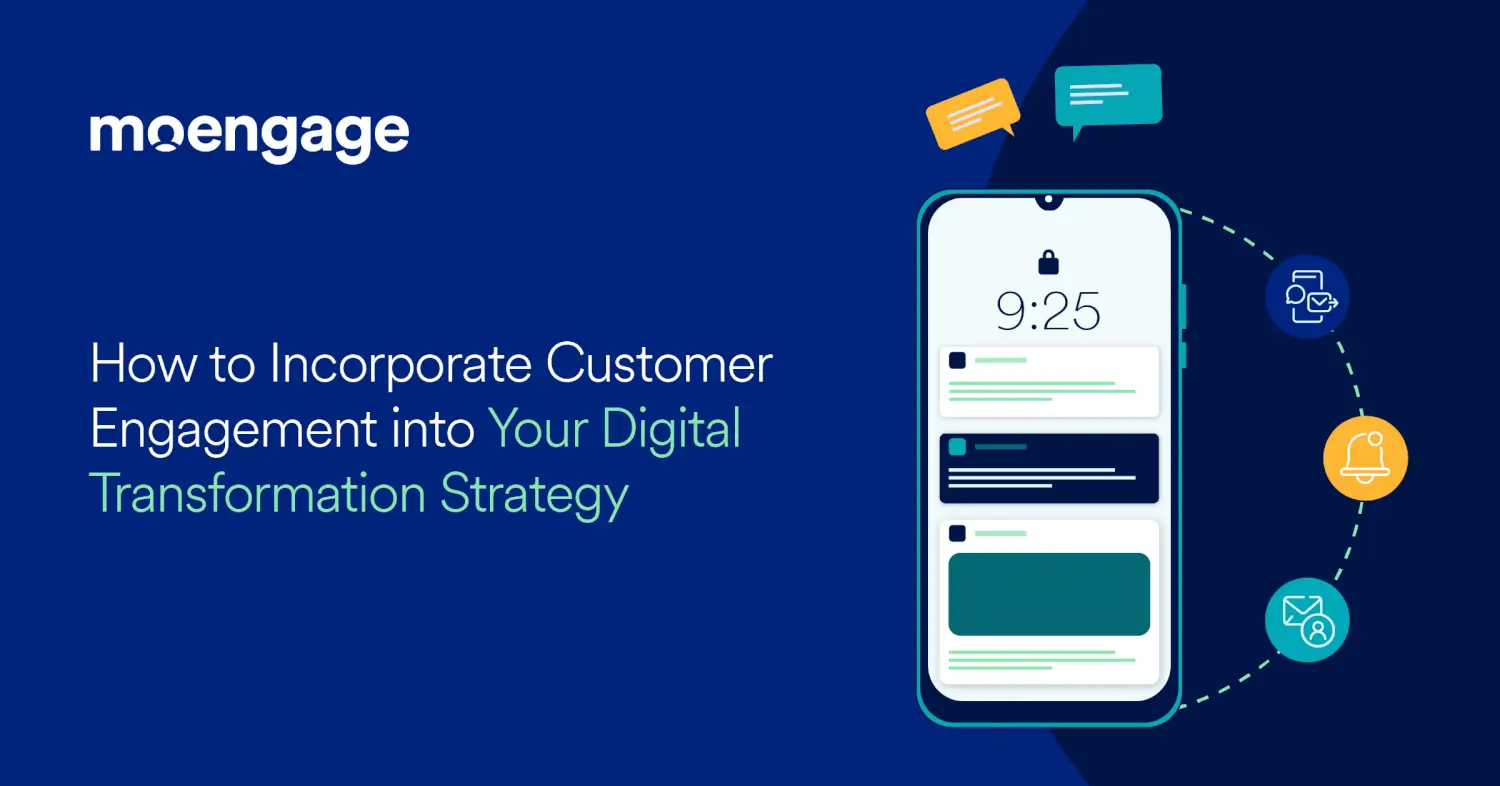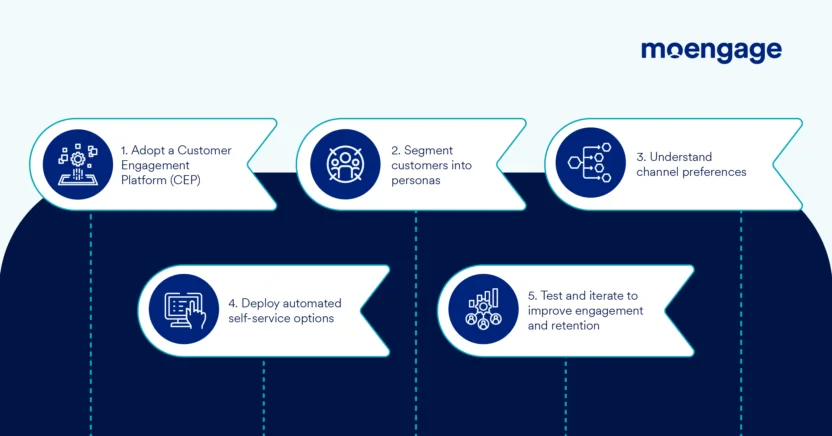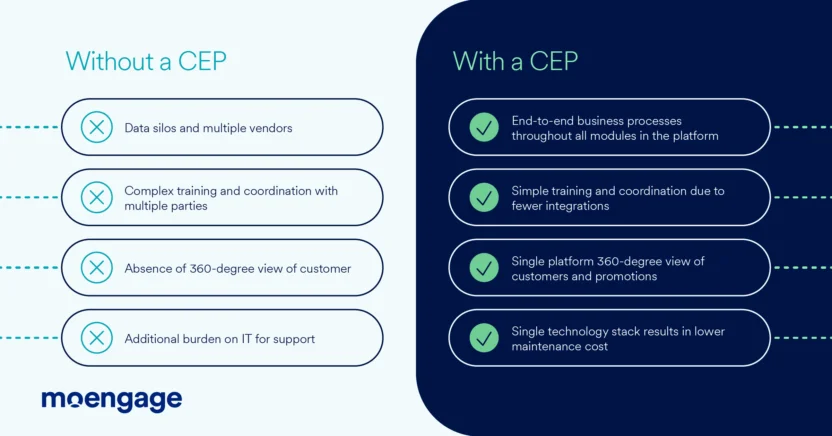How to Incorporate Customer Engagement into Your Digital Transformation Strategy

Reading Time: 9 minutes
Today’s consumers interact with brands through multiple touchpoints, rather than relying on just one. They seamlessly switch between shopping in physical stores and online, choosing the most convenient option at any given time.
Brands that fail to offer an omnichannel experience struggle to engage — and retain — customers. That’s why many enterprise brands are undergoing a digital transformation, which involves moving from a purely offline business model to a hybrid, omnichannel strategy that provides customers with an interconnected, seamless experience across channels.
But to achieve their end goal of increasing engagement, brands need to make customer engagement a cornerstone of their digital transformation, baking it into everything they do.
This article explores the urgent push for digitization, relevant customer engagement strategies to aid that transition, and the power of Customer Engagement Platforms (CEP) in making such a transformation manageable — even for the largest organizations.
Let’s jump in.
What is a Digital Transformation Strategy?
When it comes to customer engagement, a digital transformation strategy means integrating various offline and online channels to ensure a consistent experience. It’s about creating a unified, holistic experience where every channel feels like an extension of the brand, providing reliable and seamless interactions.
The Opportunities of Digitization
Going digital opens up new ways for brands to understand their customers better and make smarter, data-driven decisions. Even big players like Publisher’s Clearing House, JCPenney, Disney, and McDonald’s are looking for ways to enhance engagement through digital transformation.
For instance, when interviewed at a recent MoEngage #GROWTH event, Eve Fish, AVP of Marketing at Publishers Clearing House talked through how she has seen the company evolve as a result of technological advancements.
“PCH has gone through major transformations over the years. Earlier, we had to translate the mail to email; now, we’re in mobile apps sending push notifications. These seem very similar to direct marketing, and we apply that to different forms and platforms today.” – Eve Fish, AVP of Marketing at Publishers Clearing House
Other examples of enterprises making efforts to move from a purely physical presence to a hybrid strategy are highlighted below:
- JCPenney upgraded its in-store digital tech to create seamless shopping experiences and personalize customer interactions.
- Disney launched Disney+ and introduced MyMagic+ wristbands, merging online and physical experiences for park visitors.
- McDonald’s boosted convenience with its mobile app and MyMcDonald’s Rewards program, speeding up service and increasing engagement.
It’s clear that this move is critical, especially for businesses to relate to customers who are used to interacting with brands (and each other) across a variety of digital and in-person experiences. To further argue this point, 62% of customers feel an emotional connection to the brands they buy from most frequently, showcasing the power of building strong, personal relationships through effective customer engagement strategies.
Why is Digital Transformation Critical for Enterprise B2C Brands?
Digital transformation helps businesses meet customer expectations and operate more efficiently. It’s not just about adding digital tools; it’s about redesigning the entire customer experience to integrate physical and digital elements seamlessly.
Below are some of the key benefits of digital transformation.
- Get a 360-degree view of customers: Integrating offline and online channels means brands get consolidated data that paints a clear picture of the customers’ activity and behavior across all channels. Access to holistic analytics allows businesses to determine what information is truly valuable, how to use it, and how to reap the benefits.
- Create journeys that blend offline and online experiences: With an omnichannel approach, the customer’s physical journey doesn’t end at the check-out counter and the customer’s digital journey doesn’t end at the shopping cart checkout. Instead, engagement occurs across all channels, giving customers a seamless experience no matter the brand touchpoint.
- Personalize customer experiences at scale: An omnichannel approach allows marketing teams to deliver personalized experiences for customers based on their demographics, geographic location, past activity, overall behavior, and channel preferences, enabling brands to develop campaigns that customers love.
- Mobile-first engagement is the new norm: With mobile options being essential, mobile engagement is a core component of any digital transformation, empowering brands to reach more customers at scale.
Digital transformation is ultimately about breaking down barriers between the various channels brands use to connect with customers, whether they are online or offline.
It’s about eliminating gaps in this experience and making it easier and more convenient for customers to interact with your brand. This leads us to why digital transformation is so important for driving customer engagement today.
Why Customer Engagement Is Crucial for Digital Transformation
A disengaged customer isn’t really a customer at all. Digital transformation aims to boost engagement by blending online and offline journeys into one unified experience, which helps with customer acquisition, engagement, and retention.
Below, we look at how digital transformation helps in maximizing customer engagement.
1. Move from a campaign-centric approach to a customer-centric approach
Embracing digital channels and shifting to a hybrid, cross-channel model allows brands to prioritize the customer over the campaign.
By placing customers at the center of the experience and building curated journeys and campaigns that work for them, you can better cater to various customer needs and channel preferences. This lets you build close, meaningful connections between your brand and your customers that increase engagement, retention, and brand adoption.
Digital transformation makes this transition scalable through the use of systems that unify customer information, streamline omnichannel delivery, and automate campaign optimization.
2. Create seamless cross-channel purchase experiences
Adopting a hybrid model enables brands to create omnichannel experiences that let customers flow seamlessly between online and offline channels.
Connecting the online and offline experience allows brands to create flawless omnichannel customer journeys that meet customers where they are. Customers get a uniform, familiar experience no matter how they interact with your brand, whether they’re shopping for products, accessing financial services, consuming content they love, or ordering meals from their favorite restaurants.
Digital transformation lets businesses elevate the customer experience by removing barriers to purchase so that the customer can act on whatever purchase channel is most convenient for them at any moment.
By providing customers with an integrated, intuitive customer experience that works seamlessly across online and offline channels, brands drastically improve customer satisfaction and engagement. This attention to delivering best-in-class omnichannel experiences improves retention and turns customers into true brand loyalists.
3. Generate — and effectively target — more cross-sell and upsell opportunities
Cross-selling and upselling are the bread and butter of successful brands. They allow companies to increase sales, subscriptions, and engagement, driving up customer lifetime value (CLV). This makes each customer acquisition more valuable, and contributes significantly to the growth, success, and longevity of the company.
A hybrid approach that leverages omnichannel capabilities allows you to build cross-sell and upsell opportunities that carry across all the channels you’re using. By integrating these campaigns into their marketing strategy, brands can optimize when and where they send these messages, making them far less intrusive to the customer and more relevant, which drastically increases success rates.
4. Foster deep, long-lasting brand loyalty
Digital transformation incorporates omnichannel strategies and rich insights which fuels engagement and leads to greater — more deeply-rooted — brand loyalty.
Customers want personalized recommendations (for products, content, and restaurants) that factor in their preferences and interests. An omnichannel approach allows brands to craft incredibly personal experiences that resonate with each of their customers, drastically improving customer satisfaction and building deep, long-lasting brand loyalty.
5 Customer Engagement Strategies for Digital Transformation

When done properly, digital transformation offers brands relevant insight, allowing them to anticipate — and proactively meet — the needs of their audience. Below we have compiled various customer engagement strategies that can be implemented in your digital transformation phase.
1. Adopt a Customer Engagement Platform (CEP)
To squeeze the most engagement out of your omnichannel campaigns, the first step in a digital transformation is to adopt a Customer Engagement Platform (CEP) that will help you implement, manage, and maintain your customer engagement strategy.
Using a CEP, brands can easily and efficiently deploy an omnichannel strategy that integrates all relevant channels so that customers get a seamless, consistent experience, no matter the touchpoint they use.
With a single platform consolidating all customer engagement efforts across channels, brands get access to unified data that drives deeper insights. This empowers brands to better understand their customers and deliver hyper-personalized campaigns that drive engagement and brand loyalty.
A CEP can even help automate campaign deployment and optimization, saving your team valuable time and improving results.
2. Segment customers into meaningful personas
Customer segmentation is the foundation of any omnichannel strategy. It’s a core building block that enables brands to target and personalize their campaigns, including the content, timing, frequency, and channels.
Digital transformation empowers teams to scale their customer segmentation efforts, making it easier to conduct and extract valuable insights. Brands can conduct more complex segmentation and get more accurate, reliable results; and they can do it all faster and more efficiently. With a CEP, they can easily turn this information into an actionable plan, implementing updates or deploying entire campaigns quickly and flexibly.
Start by segmenting customers by their demographics, geographic location, previous activity, and overall behavior and habits. As you get more detailed information, you can begin to segment customers further into actionable groups, empowering you to craft customer journeys and campaigns that resonate with your customers — and lead to greater engagement.
Group customers based on their intent to buy, their loyalty levels, and more to deliver focused, targeted campaigns that connect on a deeper level by intuitively offering relevant offers and messaging. Data-driven segmentation allows brands to sort customers more efficiently into uniquely actionable personas based on customer activity and behavior patterns.
Brands that do this right know the difference between high-intent customers who just need a little nudge to complete a purchase or subscription, low-intent customers who need to be convinced of a brand’s value, and everything in between. Customers can then be grouped — and served unique marketing campaigns — based on their segment.
3. Understand — and leverage — channel preferences
When undergoing a digital transformation you need to focus heavily on the channels you’re using.
Think critically about how, when, where, and why you use specific channels. What are your priority channels? Which channels do you use for different types of messages? How do you time messages differently based on the channel being used? Make sure these choices are determined based on your customer’s preferences and habits.
Also, understand how different customer segments engage with your channels, and then develop unique journeys that leverage their channel preferences to maximize engagement.
4. Deploy automated self-service options
Modern customers don’t just want a seamless shopping experience, they want an intuitive, streamlined end-to-end experience that saves them time and prioritizes convenience. This extends beyond checkout and includes customer support options.
Digital transformation opens up new two-way communication opportunities, allowing brands to deploy automated self-service customer support options like chatbots and SMS. Customers get immediate access to customer support via their preferred channel, drastically improving their experience and satisfaction.
Self-service options are an opportunity to learn about customer difficulties, reduce their frustrations, and improve their experience by providing useful, timely, and relevant support. Data from customer questions and searches can also reveal common friction points and identify opportunities for improvement.
Ensuring guidance is accessible to your audience 24/7 builds rapport and digital transformation makes it possible for audiences of any size through automation.
5. Test and iterate to improve engagement and retention
You won’t nail things right away. Even if you do, customer behavior is constantly evolving — and you’ll need to adapt just as quickly to keep up.
Particularly in the early stages of digital transformation, businesses may not have clear data on the kind of messaging that their audiences will respond to. But to stay relevant and improve traction, you’ll need to consistently optimize your campaigns for better performance.
Use AI-powered dynamic A/B testing to compare the performance of entire campaigns, allowing you to understand more about the best tone, timing, frequency, content, and channel combinations to use to maximize engagement. Make sure you have a way of measuring your performance, using KPIs that give you meaningful insights — not just vanity metrics.
Continuously reiterate to perfect your customer experience and maximize engagement. And — most importantly — do it effectively at scale.
How a CEP Fits Into Your Digital Transformation Strategy
If the main aim of your digital transformation is to drive customer engagement, then a CEP is the natural pillar to build upon. A CEP is the main tool you’ll use to consolidate customer insights and implement your omnichannel customer engagement strategy for maximum impact.
According to McKinsey, top economic performers in digital transformation invest significantly in these strategies, often setting themselves apart with ambitious customer engagement and innovation efforts.
When used properly, a CEP helps brands execute digital transformation:
- Collect, marshal, and unify their data for deeper customer insights
- Segment customers in a meaningful, actionable way
- Orchestrate customer journeys for different customer segments
- Personalize customer experiences and campaigns for greater traction and retention
- Automate campaign optimization with AI-powered data to save time and other resources

At the end of the day, a CEP is a powerful tool for enterprise brands looking to maximize customer engagement via digital transformation. It is a core component of achieving cross-channel customer engagement successfully.
Using MoEngage to Transform Your Customer Engagement Strategy
Putting customer engagement at the center of your digital transformation lays the foundation for improved ROI. And as we’ve seen here, brands need to prioritize an omnichannel approach to customer engagement to stay competitive.
By integrating digital and physical channels, customers get a consistent, seamless experience, boosting engagement and retention. A CEP like MoEngage provides the tools needed to execute this strategy effectively.
Embrace digital transformation to enhance customer engagement, drive loyalty, and achieve long-term success. Schedule a demo of MoEngage today to start your digital transformation journey.










